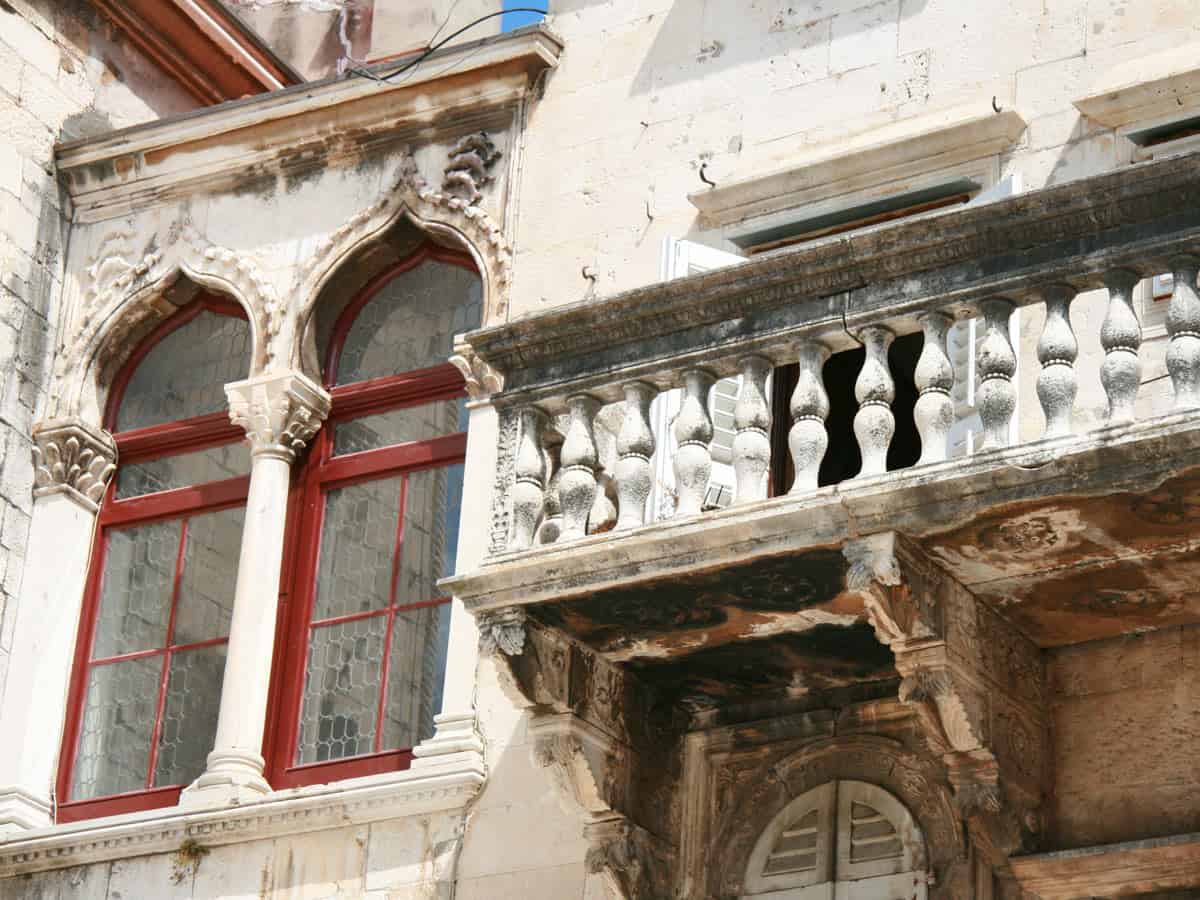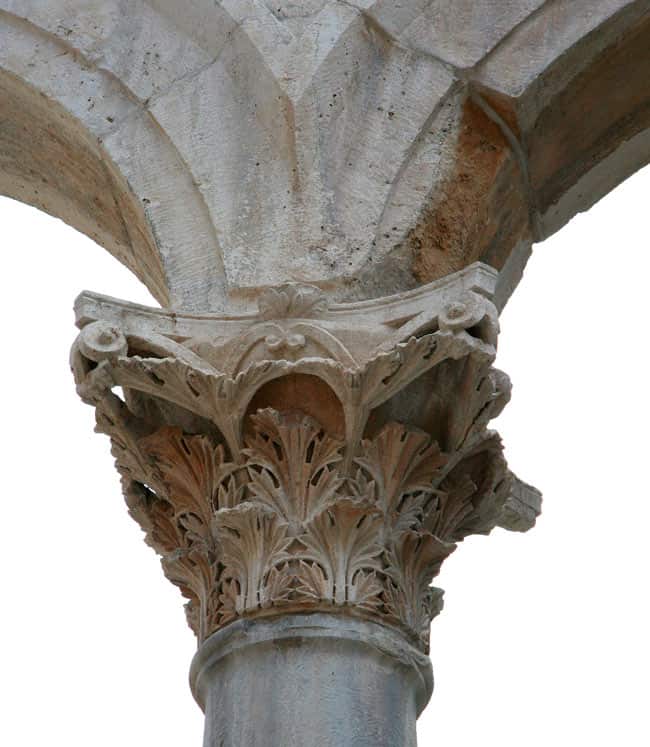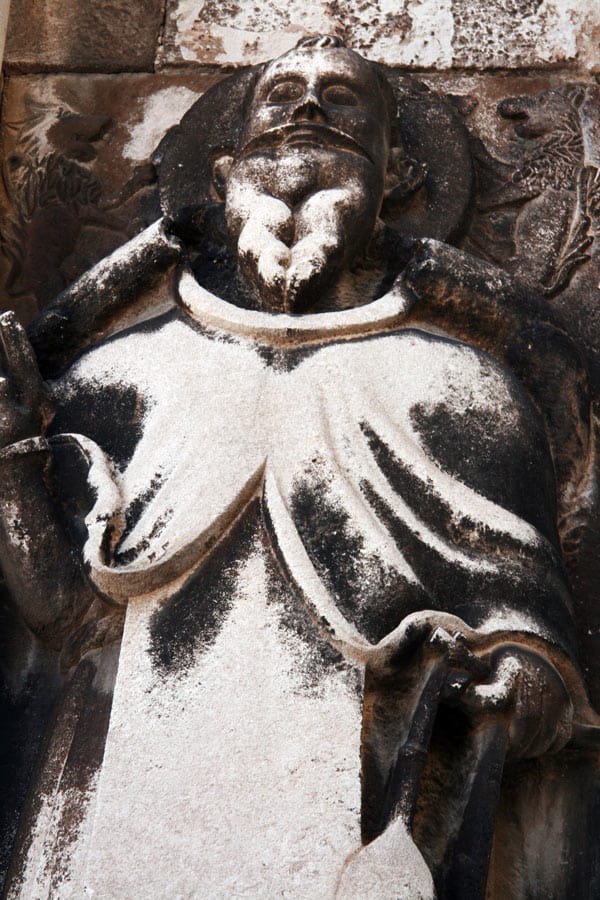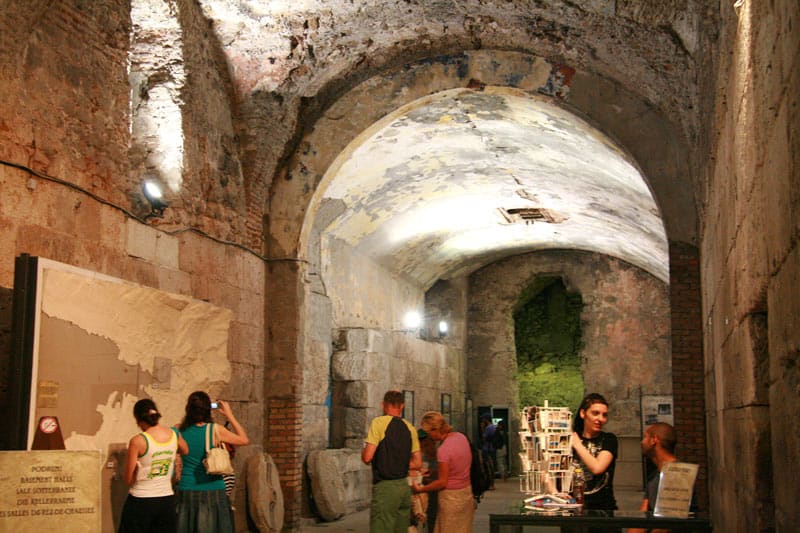Split’s Crown Jewel: Guide to Visiting Diocletian’s Palace

This post may contain affiliate links. If you make a purchase through them, we may earn a small commission (at no cost to you).
In the Croatian coastal city of Split, visitors frequently ask, “Where is Diocletian’s Palace?” Shopkeepers laughingly reply, “You’re in it!”
An ancient palace built for the Roman emperor Diocletian on the Adriatic Coast, Diocletian’s Palace today forms about half the Old Town of Split.
A UNESCO Heritage Site, these marvelously-preserved Roman ruins are also famous for being a setting for the hit TV series Game of Thrones.
Visiting Diocletian’s Palace is simply one of the best things to do in Split!
We’ve recently returned from another trip to Split (and Croatia), and the palace still has us spellbound. (It never gets old. Well, technically, it’s old. We’ll get to that…)
Here’s our guide to exploring Diocletian’s Palace – top sights, tips and must-sees.

Contents: Guide to visiting Diocletian’s Palace
Life of the Roman emperor, Diocletian
Diocletian’s Palace in Split, Croatia

If you’re visiting Split, you’ll probably also visit Dubrovnik on your Croatia trip (and walk the Dubrovnik city walls).
Diocletian’s Palace and the Split Old Town are many centuries older than Dubrovnik.
Whereas most of Dubrovnik’s Old Town was built during the 12th to the 17th centuries, Split’s Old Town dates back to at least the beginning of the 4th century.
The palace was built by the Roman emperor Diocletian as his retirement residence.
But this palace on the Adriatic Coast (more than 1,700 years old) is no lifeless ruin. It’s the beating heart of Split’s historical inner city.
More than 3,000 people live and work within the palace today, designated a UNESCO World Heritage Site in 1979.



Its immense walls surround a 10-acre tangle of temple ruins, apartments, museums, hotels, markets, coffee shops (serving decadent Croatian cakes and pastries), modern boutiques and even an ancient cathedral, all interlaced with pedestrian-only cobblestone alleys.
It’s really like a “living museum.”
So now you understand why Diocletian’s Palace is a must-visit attraction in Split!
Life of the Roman Emperor Diocletian

Diocletian was born in Salona, Croatia, a few miles outside of Split. At the time, the city was part of the Roman Empire. He rose through the military ranks and became emperor in 284 A.D. at the age of 39.
He recognized that the Empire was too large to be ruled by just one person.
So he restructured the government and established a Tetrarchy. He decentralized the Empire’s administration, splitting it into two parts, which helped to stabilize it.
At the same time, Christianity was a growing religion and a thorn for the Empire to deal with.
Diocletian’s solution was to persecute the Christians.
One of the most brutal facts about Diocletian is that he ended up slaughtering 150,000 of them. The Diocletianic Persecution was the Roman Empire’s largest and bloodiest persecution of Christians.
Not that this succeeded in squelching the new religion.
The Emperor Constantine later signed an edict in 324 A.D. protecting Christians and converted to Christianity himself on his deathbed.
Diocletian is also known as the first Roman emperor to resign voluntarily.
But before he resigned in 305 A.D., he commandeered an army of slaves to build his retirement retreat – his palace in Split.
Diocletian is believed to have spent his retirement years happily gardening. He died in 311 A.D.
Diocletian Palace history

Diocletian sure picked prime real estate on a sunny bay, lapped by warm azure waters, for his palace!
Made up of 220 white limestone buildings, the emperor’s palace was built as part luxury villa and part Roman military garrison, with two main streets. (Much of the stone was excavated from the nearby island of Brac, which is also worth visiting.)
Diocletian lived in the imperial apartments in the southern part of the palace. The military camped in the northern part, along with the servants.

Three hundred years after he died, the palace of Diocletian was converted into a town by refugees who moved in after their homes were destroyed by invaders.
Over the centuries, the citizens of Split adapted various parts of the palace to suit their own needs, and the city grew organically, spreading out over the surrounding landscape.
Where to start your palace tour: The Riva



An easy place to start exploring the palatial city is from Split’s famous Riva, the harborside promenade lined with cafés and white benches shaded by palms.
In Roman times, there was no Riva. The sea splashed against the palace walls. But there was a sea gate through which the emperor could enter by boat.
This gate – the Bronze Gate (or Southern Gate) – is one of four main gates into the Old Town.
Because it’s located by the Riva, it’s the most frequently used gate to enter the palace today.
You can also start from the Golden Gate at the north end and end up at the Riva.
If you do this top-rated guided walking tour (1½-hour “Old Town and Diocletian Palace” tour), you meet near the Golden Gate and finish at the Riva.
What to see at Diocletian’s Palace



Peristyle

Steps lead up to the Peristyle, formerly the central courtyard of the palace and now the Old City’s main square.
It’s the perfect spot to sip a kava (coffee) at one of the crowded cafés and gaze up at the lofty Corinthian columns around you.
It’s so atmospheric that it’s easy to imagine toga-clad Romans sauntering past the columns.
In high summer, the open rectangular courtyard is the open-air venue for the Split Summer Festival each July.
And at night, the Peristyle is lit up; live music or street theater often takes place here.
Cathedral of St. Domnius

On the east side of the Peristyle, there’s a black granite sphinx that Diocletian looted from Egypt (one of 12 Egyptian sphinxes shipped over to decorate his palace).
It guards the entrance to what was his mausoleum, built in 305 A.D. Diocletian was buried there after he died.
It was quite the burial memorial!
Constructed of large stone blocks, it was 74 feet high, with 9-foot-thick walls and a mosaic-tile floor. Surrounding it were 28 granite and marble columns. Diocletian’s sarcophagus stood in the center of the room.
In an ironic twist of fate, the mausoleum was converted in the 7th century into a shrine to St. Domnius, a bishop he beheaded during his persecution of the Christians. Diocletian’s remains were tossed into the Adriatic.
Now Diocletian’s mausoleum is the Cathedral of St. Domnius, said to be the oldest Catholic cathedral in the world.

Certainly, it is a striking attraction, popular with the hordes of tourists milling about.
On the main doors of the octagonal building, beautifully carved walnut and oak panels from the 13th century reflect the life of Christ.
Inside, there are decorative friezes, gold and silver artifacts, baroque paintings, beautifully carved wooden bench-rests and an intricate Romanesque pulpit.
Underneath the cathedral is the crypt of St. Lucy. The patron saint of the blind, she tragically had her eyes gouged out before being killed during Diocletian’s purge of the Christians.
Bell Tower

Perhaps the most iconic building in Split is the bell tower that rises up from the Cathedral of St. Domnius in the center of Split.
Built between the 13th and 16th centuries, it was reconstructed at the turn of the 20th century.
You can climb the metal stairs to the top of the Romanesque bell tower.
While not for the faint-hearted, you’re treated to 360-degree views of Split and the magnificent palace in all its decaying and partially restored glory.
Temple of Jupiter
Diocletian considered himself to be the son of the Roman god Jupiter. Not surprisingly, the palace is home to a Temple of Jupiter, found opposite the Cathedral of St. Domnius.
This fairly small building was built between 295 and 305 A.D. but then converted in the 6th century into the Baptistry of St. John.
Inside, look up at the frieze decorating the original barrel-vaulted ceiling.
Outside, you’ll see a large bronze statue of Saint John the Baptist, along with a headless black sphinx.
Diocletian’s Palace basement

On the southern edge of the Peristyle, accessed from the Bronze Gate, stairs lead down into a huge underground vault.
You get a sense of the grandeur of what used to be Diocletian’s private seaside quarters by wandering the subterranean chambers beneath. They mirror the layout of the upper floors.
In Diocletian’s time, the cellars of the palace were used for wine storage.
Later, in medieval times, the inhabitants threw their garbage down into this netherworld, filling the basement over the centuries.

Only in the last 50 years have excavations unearthed many of these enormous vaulted rooms, in which archaeological finds are strewn about.
Today, the main alleyway of Diocletian’s Palace basement is used as a market, with numerous shops where locals sell arts and crafts.

Split City Museum
Located inside the palace, the Split City Museum is housed in an impressive Gothic townhouse.
Three floors of exhibits provide an overview of Split’s history from ancient Roman times through to the 20th century.
We nipped in to eye the medieval weaponry, coins, paintings, photographs and sculptures on display.
The explanation boards are in English (and Croatian). It’s also air-conditioned inside, and the entrance fee is barely $3 USD.
It’s definitely worth popping into this Split museum to gain a better understanding of the city’s history.
Diocletian Palace gates

The four Split gates all lead to the Peristyle in the center of Diocletian’s Palace.
And you’ll want to see them all!
Bronze Gate, Split
We’ve already mentioned that the Bronze Gate (Porta Meridionalis) on the Riva is the main entrance to the palace. It’s also the most modest of the gates. Most Diocletian Palace tours start here.
Silver Gate, Split
The Silver Gate (Porta Argentea) is the Eastern Gate.
Pope John Paul II passed through this gate in his “Pope mobile” to reach the St. Domnius Cathedral, when he visited Split in 2000.
Just beyond the palace’s outer walls is the Split Green Market, which is a bustling fruit and vegetable market.
Iron Gate, Split
The Western Gate is the Porta Ferrea (Iron Gate) and it connects the palace to the People’s Square or Piaca just outside the western side of the palace walls.
In the Middle Ages, Split grew so much that a “new” town square along with beautiful family palaces were built outside the Iron Gate.
Today, you find lots of great places to eat in the Piaca.
Golden Gate, Split

The Golden Gate (Porta Aurea) or Northern Gate is the grandest.
It was the gate originally used by the emperor to enter the palace. But it’s not made of gold.
We exited the Golden Gate to see the prominent statue by Ivan Mestrovic outside (covered next).
Ivan Mestrovic statue

Just beyond the Golden Gate, the towering 25-foot-tall statue of the 10th century Bishop Gregory of Nin (Grgur Ninski) by Croatia’s most famous sculptor Ivan Mestrovic caught our eye.
Legend has it that rubbing the statue’s shiny big toe brings good luck.
We rubbed the toe – feeling pretty lucky already to be in Split, Croatia – then returned back through the gate to lose ourselves once more in this extraordinary palatial city.
Practical information for visiting Diocletian’s Palace, Split



Diocletian’s Palace entrance fee
It’s free to walk around inside the Palace of Diocletian – it’s all part of central Split.
You need tickets, however, to visit certain parts of the palace:
- Basement of Diocletian’s Palace
- Cathedral of St. Domnius Treasury (and crypt underneath)
- Jupiter Temple
- Split Bell Tower (to climb it)
You can purchase a combined ticket for all at the Peristyle.
Diocletian’s Palace opening hours
The Peristyle is always open.
From June to September, St. Domnius Cathedral is generally open daily from 8:00 am to 8:00 pm. Opening hours are reduced at other times of the year.
Diocletian’s Palace Game of Thrones tour
If you’re a fan of HBO’s TV series Game of Thrones, you may know that Diocletian’s Palace features in Seasons 4 and 5.
The narrow streets of the palace were the setting for numerous scenes for Daenerys Targaryen (played by Emilia Clark).
In particular, the palace cellars were where she kept and trained her dragons. The cellars also served as the location for her throne room in Mereen.
Several Game of Thrones location tours are offered.
Here’s a 5-star-rated walking tour of Diocletian’s Palace with a Game of Thrones fan as your guide (2 hours).
Final thoughts

This ancient Roman palace – full of modern life today – is one of the most splendid attractions in Croatia. You’re sure to be as entranced by it as we were!
More Croatia travel guides
- The Perfect 14-Day Croatia Itinerary (Dalmatian Coast)
- 10 Best Coastal Cities and Towns in Croatia
- 17 Wonderful Things to Do in Hvar
- The 15 Best Things to Do on Brac Island
- Visit Trogir: The Tiny Croatian Town Nicknamed “Little Venice”
- 21 Delightful Things to Do in Split
- 15 Best Dubrovnik Beaches
- Get High! Walk the Dubrovnik City Walls
- 33 Delicious Croatian Desserts You Must Try!
Inspired to visit Split? Then pin this!


Our top travel tips and resources
General trip planning: TripAdvisor is a helpful starting point, offering loads of user reviews on hotels, restaurants and things to do.
Hotels: Booking.com is our go-to for scoring a “wow” hotel – or at least a decent one – often at lower rates than the hotel’s own website. We especially like Booking’s flexible cancellation policy! (You may prefer Expedia for booking hotels in the U.S. or Mexico.)
Vacation homes, condos and rentals: We prefer and use Vrbo (Vacation Rentals by Owner).
Flights: For the cheapest flights, search on Google Flights or Expedia. (Just be aware Expedia tickets are often non-refundable. If you want more flexibility, it’s usually worth booking directly with the airline, even if it costs a bit more.)
Airport lounge access: We love (and have) Priority Pass for comfy lounge seats, free snacks and drinks, complimentary WiFi and sometimes even showers and spa services!
Tours: For the best local food, walking and other guided tours, plus skip-the-line tickets to attractions, check out Viator (a TripAdvisor company) and GetYourGuide.
Car rental: Renting a car is often a great way to explore off the beaten path. Discover Cars searches car rental companies so you get the lowest rates.
eSIMS: Stay connected affordably with Airalo eSIMS covering 200+ countries and trusted by 10 million+ users, including us! (No more huge roaming bills!)
Travel insurance: SafetyWing is designed for frequent travelers, long-term adventurers and digital nomads. It covers medical expenses, lost checked luggage, trip interruption and more. We also have and recommend Medjet for global air medical transportation.
Travel gear: See our travel shop to find the best luggage, accessories and other travel gear. (We suggest these comfy travel sandals for city walking, the beach and kicking about.)
Need more help planning your trip? Check out our travel tips and resources guide for airline booking tips, ways to save money, how to find great hotels and other crazy useful trip planning info.
If you make a booking or purchase through our site, we may earn a small commission (at no cost to you). Thanks!
About the authors

